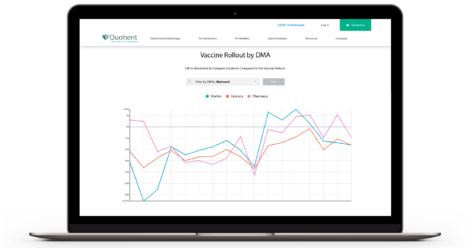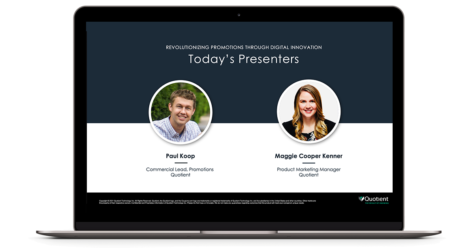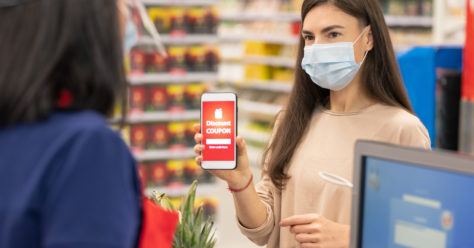Reach vs. Clicks: How Can Brands Drive Sales on Social
Aimee Green, Quotient’s Manager of Social Trading, is responsible for creating and running social media ad campaigns on everything from Facebook to Instagram, Pinterest, Snapchat and even TikTok. In our recent spotlight interview, Aimee talked about the performance metrics that she thinks are the most effective for driving sales as well as the importance that ad creative plays in overall campaign performance.
Keep reading for more insight into Aimee’s work on the Quotient Social Platform.
You’ve done research about optimizing ads on different platforms. Can you share any kind of high-level insights that you've found?
For many brands, their first instinct when looking at a social campaign is to optimize towards clicks because they think clicks are somehow associated with purchase intent. They measure how well a campaign is or isn’t performing based on the number of clicks it has. But in my experience, clicks aren’t necessarily tied directly to sales—and there’s been plenty of third-party research done on this as well.
It boils down to working with the platforms and working against the platforms. The goal is to deliver the message to the user where they are and how they're expecting that information to be delivered to them. So for example, people consume ads and content differently if they are on Snapchat than if they are on Instagram.
Sometimes, I'll get an ad that has a lot of clicks but the auction is telling me that it isn’t efficient to serve. Advertisers may want to ignore the auction, to work against it and push that ad because of the high number of clicks. But my recommendation is to do the opposite. The auction, the algorithm and the platform will tell you exactly how well the ad is doing, so focus on being strategic about how you set your campaigns up, how sophisticated your targeting is and whether or not your creative matches your targeting and the platform that it's being run on.

What KPIs would you recommend that brands optimize towards?
Popular KPIs are either sales or awareness, and there are plenty of studies you can do behind this. But my favorite KPI for advertisers is reach, which is essentially the unique number of people that saw your ads.
It's not that clicks and engagements and likes are a bad thing. But when an advertiser decides to focus on clicks, they may be optimizing away from reach and impressions to get those clicks. And that can be limiting depending on what the ultimate goal of the campaign is."
My main focus is usually getting people in the store or on the eCommerce site. We want them to remember us when they sit down to make their grocery list and build their cart. Advertisers can accomplish this on social media by using sophisticated, personalized targeting. Digital offers a lot of advantages to brands because they can be very deliberate in who sees their ads. The products that appear in people’s social feeds should be something that will actually appeal to them—whether it’s a brand they’ve purchased in the past or a product that we think they’ll buy in the future based on which categories they typically shop.
Ultimately, this points back to why I believe impressions are such a key metric. By optimizing towards reach, you’re ensuring that your brand and your product get in front of as many people as possible. In my experience, this strategy is how sales go up.
How does the creative play into ad performance?
Creative plays a huge part! And it is really hard to judge creative. It's not as definitive as certain colors or styles always performing well. There is a lot more nuance behind it.
A/B testing is key when it comes to creative. How this works is we run two ads that look exactly the same, use the same copy, have the same targeting and run on the same platforms. Except one element of the creative will be different. That testing tells us which ad the auction preferred more and served more so that it was easier to get that higher reach. For example, we’ve found that the algorithms of multiple social platforms really prefer movement and GIF-style ads.

Branding at point zero is another big thing with creative. And what I mean by that is the moment an ad loads on the page, we want consumers to immediately know what brand it’s for. Whether it’s by showing a logo or spelling out the product’s name, consumers should see that clear branding as soon as an ad loads on their screen—especially since people's attention spans on digital are so short.
There’s a new generation of consumers that are used to quickly consuming incoming snippets of information. A second might not sound like very long, but it’s really all you need. If your branding is done well and done clearly, social ads are a great way for brands to increase their reach and effectively drive sales.
What excites you about how Quotient is positioned in this space?
I think one of the coolest things is that we provide content. Our in-house design team will tailor content to many platforms to make sure it is working efficiently and working the best for your brand.
And then on top of that, we are able to optimize on each of those platforms. We can offer advertisers a whole portfolio plus the ability to create content to promote. And we have valuable data about how content should look on every single platform. That’s especially important because brands should optimize on the platforms that are working best for them rather than running campaigns on platforms that aren’t performing as well.
We hope you enjoyed this Q&A with Aimee. To see how we can help you engage consumers online, check out the Quotient Social Platform page or email us at communications@quotient.com.



